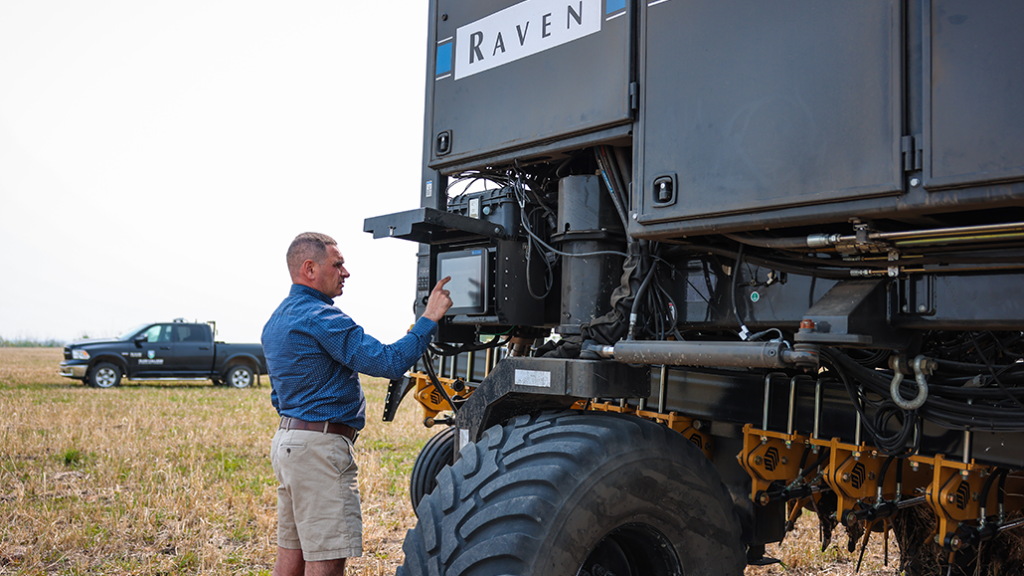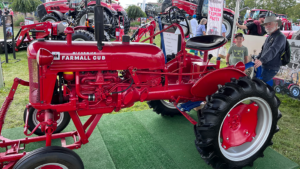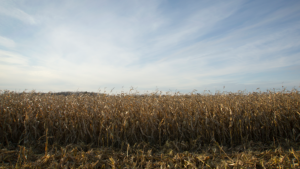Farming smarter
EXPANSION OF THE PAN-CANADIAN SMART FARM NETWORK

DISCOVERY FARM WOODSTOCK is now part of a nationwide agricultural technology research network designed to test, troubleshoot, and develop practical farming technologies.
| WHAT YOU NEED TO KNOW • Established by Olds College in Alberta, the Smart Farm Network now has eight locations in four provinces. • The Discovery Farm site in Woodstock, Ontario, (home to Canada’s Outdoor Farm Show) joined the Smart Farm Network in 2023. • A wide range of research initiatives are underway, including researching and evaluating autonomous equipment like the Raven OMNiPOWER platform. • At the Olds site, research includes collecting data on soil and fertilizer emissions in a field crop setting. • Research conducted by the Smart Farms can benefit many aspects of society. Water quality research could be applied to municipal storm ponds or water treatment processes. |
Established and led by Olds College in Alberta, the Smart Farm Network is now comprised of eight locations across four provinces. The multi-region collaboration has multiple directives — to enhance the efficiency, sustainability, and resilience of Canadian agriculture — with regard to both emerging opportunities and challenges facing Canadian farmers.
The addition of the 330-acre Discovery Farm in Woodstock, Ontario will support agricultural technology research in a number of ways. As described by a Discovery Farm press release published on August 2, 2023, the Smart Farm network can now leverage specific expertise in corn and soybeans, different soil types, and other production realities and characteristics unique to Ontario and Eastern Canada. Both crop and livestock research comprise elements of the Discovery Farm contribution.
Established in 2021, a wide range of research initiatives are already underway through the Smart Farm Network. Several projects at the head campus in Olds, Alberta, were showcased this past summer when journalists and communications professionals descended on the college campus for the 2023 International Federation of Agriculture Journalists (IFAJ) congress.
TROUBLESHOOTING AUTONOMY
In-field autonomy has been identified as a priority Smart Farm research area. In 2019, Olds College acquired a Raven OMNiPOWER platform (previously called DOT) to further the economic, environmental, and logistical benefits of autonomous agricultural equipment for broad-acre crop production.
Yevgen Mykhaylichenko, professor and technology integration specialist at Olds College is the machine’s primary operator. He and his colleagues have trialed the platform using its seeder, spreader, and sprayer attachments. About 17,000 acres have been covered as of July, 2023, with researchers examining a variety of data points — how efficient and effective is it compared to non-autonomous equipment? What logistical kinks need to be remedied? — and delivering their findings to Raven for further improvements.
Mykhaylichenko, a Ukrainian with an extensive history working with agricultural equipment around the globe, first came to Olds College on the recommendation of a colleague.
One of his first tasks at the college was to develop agricultural technology courses covering subjects such as GIS (geography information systems) and telematics (information technology dealing with long-distance transmission of information).
Speaking to IFAJ congress delegates in late June, Mykhaylichenko highlighted the possibilities of operating autonomous machines from anywhere in the world — including active war zones. Mykhaylichenko currently splits his time between the Olds College Smart Farm and the front line of the war in Ukraine. There, he delivers and trains Ukraine’s armed forces in the use of drones. In between, he operates OMNiPOWER.
“I open my laptop from Ukraine at the front line, connect to Starlink, ask the students to start the engine and warm up the hydraulic system. I plan and operate the robot from Ukraine while they are working in Alberta,” he says. “I am proud of my students and team in Olds College. They support and motivate me every time when I fly to Ukraine.”
MEASURING NITROGEN EMISSIONS
Olds College Smart Farm researchers are also collecting hard data on soil and fertilizer emissions in a field crop setting.
Using a series of small, domed chambers set up in the field, information about how much greenhouse gas (nitrous oxide, specifically) is being emitted from different amounts of applied fertilizer is being measured. Three different fertilizer treatments are being tested — a standard agronomist-prescribed rate, a rate with an additional 30 per cent, and one with 30 per cent less than the prescribed rate.
The project is part of a wider effort to determine how fertilizer use correlates with fertilizer emissions and yield. Finding the right rate for high yields and lower emissions — rate being one of the nutrient management Four Rs — is the tricky one. Millions of data points from the domed chambers are gathered every day.
IMPROVING WATER QUALITY
Another project seeks to help farmers — and, potentially, municipalities and other groups — clean up waterways and water bodies through the use of floating islands of wetland plants.
Buffer strips and other wetland plant vegetation along the water’s edge absorb and filter nutrients and other contaminants. The idea, says Daniel Karren, an ecohydrologist and one of the researchers involved in the project, is to expand the amount of edge vegetation to a point where contaminated water can be re-used.
Currently, they are gathering data from a pond with five per cent floating island coverage (each island is approximately 32 square feet). The islands themselves are self-perpetuating, meaning little maintenance is required. They are also inexpensive — something Karren believes makes their adoption by farmers more likely.
Although the campus demonstration site focuses on livestock farmers and the need to reduce the costs associated with trucking drinking water to feedlots — a particularly expensive task in light of the drought conditions experienced across the Canadian West — Karren says floating islands of grasses and other plants could be employed anywhere water quality needs to be improved, such as in storm ponds or water treatment processes. He adds it might be possible to target different contaminants with different plant species.
These are just a few examples of Smart Farm research and extension initiative. More about the Olds College Smart Farm, Woodstock Discovery Farm, and other Smart Farm locations and initiatives is available at www.oldscollege.ca/Smart-farm-research. •









